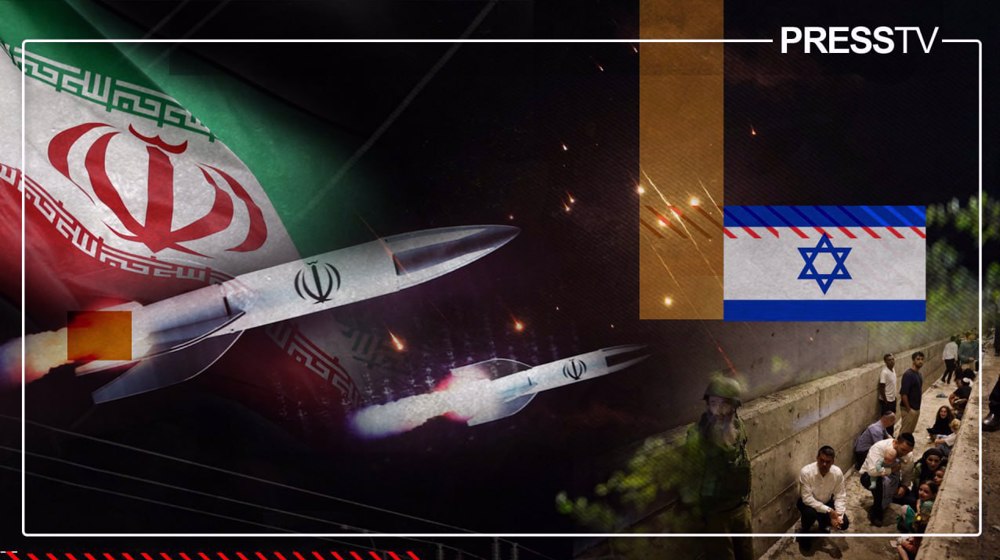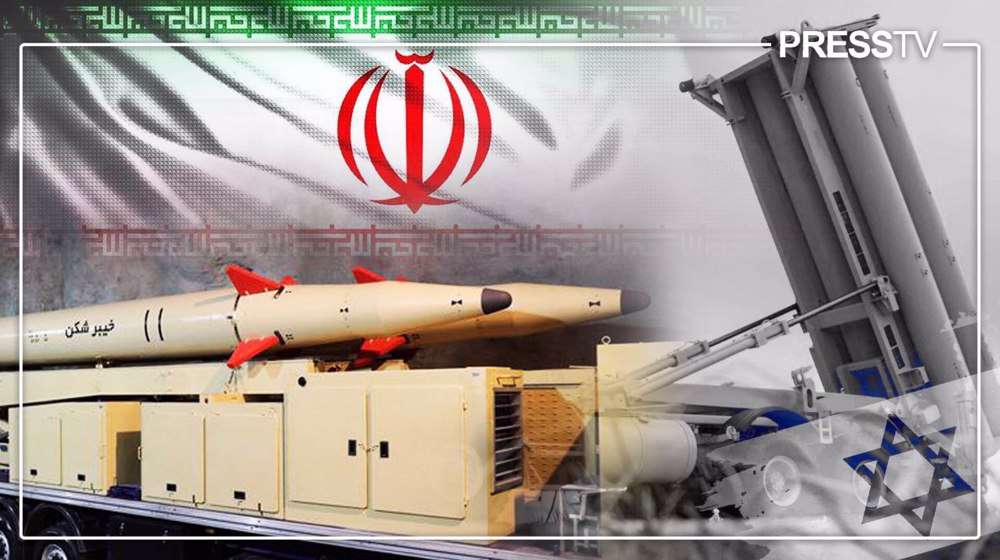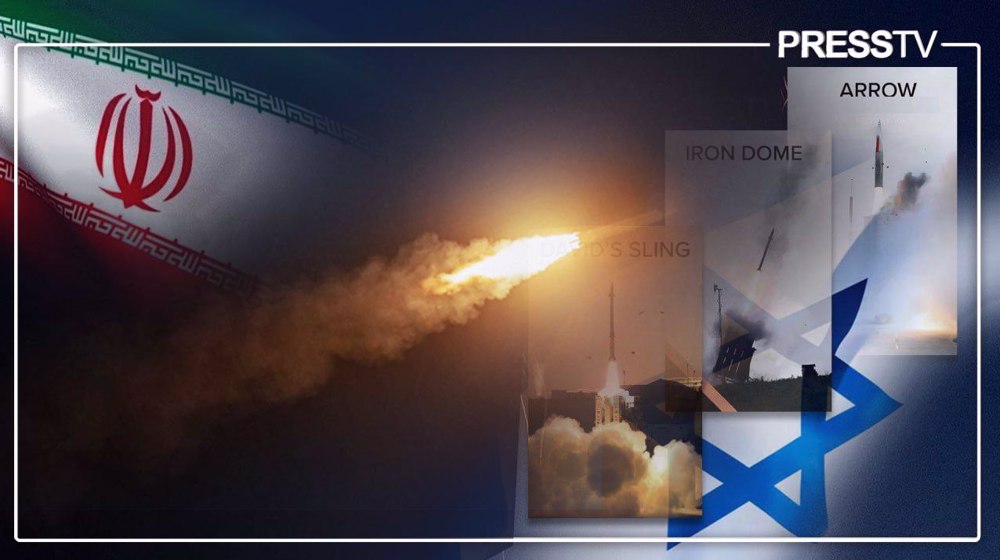Why Iran's Kheibar Shekan-2 can overpower THAAD anti-missile system
By Press TV Website Staff
Amid rising tensions in the region, the United States is reportedly deploying one of its most advanced ballistic missile defense systems, the Terminal High Altitude Area Defense (THAAD), to the occupied Palestinian territories.
The potential deployment of THAAD is intended to strengthen the Israeli regime's missile defense capabilities in preparation for anticipated large-scale Iranian ballistic missile strikes, should Israel respond to Operation True Promise II.
Iranian officials have in unequivocal terms warned that any further military provocation from the Israeli regime and its backers would result in a "crushing" response.
Many military analysts believe that the deployment of THAAD to the Israeli-occupied territories suggests that Israel’s much-hyped air defense systems have been ineffective against advanced Iranian missiles as witnessed recently.
THAAD offers a higher-end ballistic missile defense solution compared to the Israeli regime's existing systems, such as Arrow-3, Arrow-2, and David’s Sling, though it comes with a significantly higher cost, according to military experts and strategists.
Equally crucial to the THAAD system is its X-Band AN/TPY-2 radar, an advanced ballistic missile defense sensor already used by the Israeli military.
Earlier this week, Iran's state broadcaster IRIB released footage showing the transportable Raytheon X-band radar, part of the THAAD system, being knocked out by Iranian forces moments before a barrage of missiles struck Israeli military sites during Operation True Promise II.
🇺🇸 THAAD vs. 🇮🇷 Kheybar-Shekan-2
— Patarames (@Pataramesh) October 13, 2024
➡️ Avoid to defeat
🇮🇷 KS-2 can fly below the effective engagement envelope of the 🇺🇸 THAAD ballistic-missile-defense system
To achieve that, it needs to glide for ~250km and the last ~150km below an altitude of ~35-40km
➡️ The aero-ballistic… https://t.co/C0HuWXQX75 pic.twitter.com/Y4IXCNQGE4
The addition of more of these early warning radars is intended to create redundancy in case some are destroyed by Iranian precision-strike ballistic missiles.
This redundancy is deemed vital, especially given the advanced Iranian missiles that contributed to the large-scale failure of Israel's missile defense system on October 1.
Iran's Kheibar Shekan-1 and Kheibar Shekan-2 aero-ballistic missiles easily penetrated Israel's much-touted air defenses, particularly the Arrow-3 and David’s Sling systems.
The Kheibar Shekan-1 evaded the Arrow-3 system, which operates only outside the atmosphere, by flying below its engagement envelope. By the time it came within range of the Arrow-2 system, it was already flying too low to be effectively intercepted.
The missile's evasive maneuvers also allowed it to easily defeat David’s Sling system.
However, THAAD offers a notable advantage, allowing engagements at lower altitudes than either Arrow-3 or Arrow-2, thanks to its advanced kill vehicle, which is designed to operate within the lower atmosphere.
This capability makes the THAAD system potentially more effective against the Kheibar Shekan-1, according to some military experts.
However, the equation changes with the Kheibar Shekan-2, which has a longer range of 1,800 kilometers compared to the 1,450-kilometer range of the Kheibar Shekan-1.
The Kheibar Shekan-2’s more aerodynamic glide vehicle allows it to "trade" its extended range for low-altitude gliding, keeping it below the THAAD system’s engagement envelope, particularly at altitudes below 35 kilometers.
Op. True Promise II: Iran launches hundreds of missiles at Zionist entity, 90% hit targets
— Press TV 🔻 (@PressTV) October 2, 2024
Follow Press TV on Telegram: https://t.co/B3zXG73Jym pic.twitter.com/IxJfhOOZyE
This enables the missile to bypass THAAD entirely and effectively and reach its target.
While this maneuver places significant heat stress on the Kheibar Shekan-2’s glide vehicle, it is an effective method to evade THAAD and strike its intended targets, possibly including THAAD batteries themselves.
Given that American personnel operate these batteries, Iran might opt not to target them directly, instead focusing on defeating them by staying outside their engagement range.
Alternatively, Iran could choose to target the forces operating the batteries, as this would indicate direct American involvement in Israeli aggression against the Islamic Republic, believe military analysts.
While the Kheibar Shekan-2 is well-placed to evade THAAD, the Kheibar Shekan-1 also has a credible chance of defeating the system by targeting sites near the edge of THAAD's engagement envelope, which is significantly reduced when dealing with aero-ballistic missiles within the atmosphere.
Despite THAAD’s advanced technology, its high cost limits the number of available interceptors, especially compared to the sheer volume and size of Iran's ballistic missile arsenal.
As a result, THAAD’s contribution to the Israeli regime's defense may be largely symbolic, offering additional radar support and protecting high-priority sites, like Nevatim Airbase, from less advanced Iranian missile threats.
However, its effectiveness diminishes sharply when facing more sophisticated threats like the Kheibar Shekan-2.

IRGC: Iran’s military capabilities ‘non-negotiable’; national security ‘red line’

One year since Op. True Promise I, when Israel unraveled like spider’s web

Iran, Armenia to hold joint military drills to bolster border security, combat terrorism
VIDEO | Your children will return in coffins torn apart by Israeli missiles: Hamas to captives’ families
Hezbollah censures Israeli settlers’ storming of al-Aqsa Mosque
Harvard-Trump dispute deepens as US president threatens to remove tax exemption
Maldives bans entry of Israelis in ‘resolute solidarity’ with Palestinians
Iran’s thermal power output hit record in year to March
Hamas calls for global protests against Israel's 'barbarism' in Gaza
Hamas says lost contact with group holding Israeli-American captive in Gaza
Iran condemns Israeli war crimes in Gaza, West Bank












 This makes it easy to access the Press TV website
This makes it easy to access the Press TV website